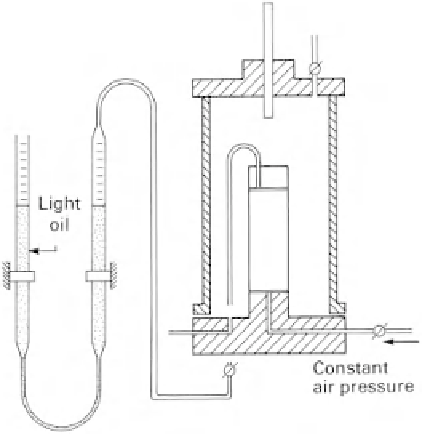Environmental Engineering Reference
In-Depth Information
partial differential equation is mathematically nonlinear. The
above equation provides a smooth transition between unsat-
urated and saturated conditions when the soil properties are
written as functions of state variables.
The air flow properties have a smooth transition from com-
pletely dry, unsaturated soil conditions to saturated soil condi-
tions. A dry soil has high pore-air permeability. The pore-air
conductivity decreases and eventually may become negligible
as soil suction decreases and the soil moves toward satura-
tion. However, air flow continues to take place as air diffusion
within the pore-water phase.
the compressibility characteristics of the soil. Changes in
the soil volume-mass properties (i.e.,
S
,
e
,or
w
)alterthe
coefficients of permeability for the soil.
An alternative permeability testing procedure involves
changing the net confining pressure
(σ
−
u
a
)
and the matric
suction
(u
a
−
u
w
)
in order to change the volume-mass
properties. This procedure has been used to obtain direct
measurements of the air and water coefficients of permeabil-
ity. An increase in the all-around stress
σ
on an unsaturated
soil will result in a decrease in total volume, even when the
water phase is undrained. The result is an increase in the
degree of saturation and a decrease in matric suction. These
changes affect the coefficients of permeability with respect
to water,
k
w
, and air,
k
a
.
The net normal stress of an unsaturated soil can be
altered using a one-dimensional odometer [Massachusetts
Institute of Technology (MIT), 1963; Barden et al., 1969b]
or a triaxial permeameter cell (Matyas, 1967; Barden
et al., 1969b; Barden and Pavlakis, 1971; Blight, 1971).
Permeability measurements performed using an odometer
sometimes encounter difficulties in obtaining a reliable seal
between the soil specimen and the odometer ring when the
matric suction is increased (Barden and Pavlakis, 1971).
9.6.7 Boundary Conditions for Air Flow
Several types of boundary conditions can be applied at the
boundaries of an air flow problem. The boundary conditions
for air flow bear a similarity to the boundary conditions pre-
viously discussed for water seepage problems. The
Neumann
boundary condition corresponds to the total air flowing nor-
mal to the boundary surface. The Neumann boundary condi-
tion does not differentiate between the type of air flow (i.e.,
whether it is free air flow or dissolved air flow).
The other type of primary boundary condition that can
be applied is called a predetermined pore-air pressure value
(i.e.,
Dirichlet
boundary condition).
9.7.2 Triaxial Permeameter Cell for Measurement
of Low Air Coefficients of Permeability
The triaxial permeameter cell shown in Fig. 9.10 was devel-
oped by Matyas (1967) to measure the air coefficient of
permeability. The soil specimen was placed between two
dry coarse porous stones. A soil specimen was subjected
to an isotropic confining pressure
σ
(i.e., cell pressure). A
constant air pressure was applied to the base of the speci-
men. The outflow of air from the top of the specimen was
9.7 DIRECT MEASUREMENT OF AIR
COEFFICIENT OF PERMEABILITY
There are direct and indirect methods available for obtaining
the coefficient of permeability with respect to air,
k
a
. Indirect
methods for calculating the air coefficient-of-permeability
function make use of the SWCC. The indirect methods of
computing the air permeability function are discussed later
in this chapter.
The air permeability of a soil can vary over a wide range.
Fine-grained soils such as silts and clays may experience
low air flow rates and the system for measuring air flow
may need to be quite different from a system required for
a coarse-grained soil that may have a high flow rate. Direct
steady-state methods are preferable to transient testing pro-
cedures due to the compressibility of air.
9.7.1 Steady-State Air Permeability Measurement
in Fine-Grained Soils
The testing procedure used for the direct measurement of
the water coefficient of permeability
k
w
can also be used in
the measurement of the air coefficient of permeability
k
a
.
In principle, the air and water coefficients of permeability
can be measured at different water contents by changing the
matric suction of the soil. A change in either the pore-air
pressure
u
a
or the pore-water pressure
u
w
causes a change
in matric suction accompanied by a change in the volume of
water in the soil. The total volume or the void ratio of the
soil may or may not change significantly, depending upon
Figure 9.10
Triaxial permeameter for measuring air coefficient
of permeability (after Matyas, 1967).










Search WWH ::

Custom Search